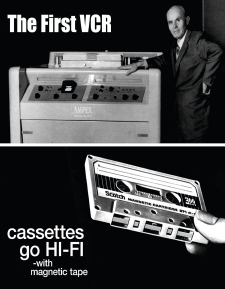First VCR + Cassettes Go Hi-Fi, The (Blu-ray Review)

Director
Dwayne BuckleRelease Date(s)
2019 (February 28, 2023)Studio(s)
Vision Laboratories (ETR Media/Vinegar Syndrome)- Film/Program Grade: C-
- Video Grade: A-
- Audio Grade: B+
- Extras Grade: C-
Review
This is a real oddity: two short documentaries produced, written, directed and edited (sound and picture) by Dwayne Buckle, produced on a professional level, yet stubbornly presented in ways that are ultimately unsatisfying and unappealing.
The main attraction, at least for me, is The First VCR, subject matter ripe for exploration from several vantage points. I certainly remember the earliest, pre-Blockbuster days of home video, when videocassettes were kept locked-up in glass display cases like precious jewels, typically in the back-corner section of stores primarily selling something else: household appliances, rare coins and stamps, at gun shops. Yearly memberships were pricey, often $100 or more, all to access vast collections of maybe 40 or 50 titles, most in the public domain. The earliest VCRs were enormous and prohibitively expensive; I’d rent one on weekends until I could finally buy my first VCR in 1985.
That would make an interesting subject for a documentary. So, too, would an exploration of the movie industry’s early resistance to home video (and, before that, private ownership of 16 mm and 35 mm prints). The early format wars—not just VHS and Betamax, but also early LaserDisc and CEDs—is yet another tantalizing topic.
None of these things is what The First VCR is about. The title itself is a misnomer, as the film itself points out in its opening minutes. Despite its title, the film isn’t about the first VCR (video cassette recorder) but rather the first VTR (video tape recorder), specifically the AMPEX quadruplex VR-1000A, which in 1956 became the first commercially successful (two-inch) videotape recorder, used by television networks and affiliates.
That wouldn’t be too much of a cheat—the AMPEX story is also interesting—but the film unfolds like a glorified PowerPoint presentation. Mixing archival photographs, a tiny bit of PD stock footage, and a smattering of new material (in shots often held way too long and/or repeated to the point of madness), The First VCR plays like a Wikipedia entry in video form, tracing back to Thomas Edison the gradual technological advancements made in audio recording and efforts to preserve moving images. The documentary is nearly half over, focusing as it does more on audio recording in its first half, before it gets into the development of the AMPEX system during the 1950s. Buckle had limited access to archival photos, so the same 4-5 images of people standing around the device are repeated endlessly.
There are no on-camera interviews, nor does Buckle’s script make much effort to flesh out and humanize any of the technology’s developers. As the subject matter is already rooted in sophisticated technology, the documentary lingering on shots of VCRs, cellphones, computer monitors and, in archival photographs, the comparatively prehistoric devices, the film all but screams for a bit of humanizing. Even the narration, while professionally delivered, is less genial than Robby the Robot in Forbidden Planet.
Further, there’s nothing like clips of tests made by AMPEX, or early examples of television programs recorded using the AMPEX and its 2-inch videotape. While licensing such material can be expensive and legally complex, the complete absence of any examples would be like making a documentary about The Beatles in which not one Beatles song is heard, and no film footage, only photographs, appear. At one point, stock footage of an old Western is made to appear something like an AMPEX recording, but this isn’t enough.
Buckle’s style is rather eccentric. He applies some documentary clichés, like adding artificial “scratches” to old-timey footage, a trite convention of most documentarians, but elsewhere he adds off-putting effects: the screen goes to black (or white) or gets “wavy” (like a dodgy video signal) at strangely chosen moments, often holding on these images for too long. Sometimes there are cutaways to what look like floating embers against a black sky. Most jarring is that while most of his sound mix channels everything to the front speakers, sometimes the mix of ambient sounds abruptly switches to the surround speakers and elsewhere, even distorting and drowning out the narration. The musical scoring is frequently inapt as well.
Cassettes Go Hi-Fi, the second feature, which traces the development of the compact audio-cassette tape, is stylistically identical with all the same problems, though it does source a slightly wider variety of images.
While Buckle does a reasonably good job noting the cultural, scientific, and historical importance of these technologies, there’s also an absence of passion essential to the best documentaries. No biographical information on Buckle is included with the disc, but IMDB reports that these were but two of nine short documentaries he released in 2019 alone; others include Swipe Right (about online dating), Saggin’ (about the fashion trend of sagging jeans) and Ancient Astronauts. I can’t spot any trends.
An ETR Media release through Vinegar Syndrome, both titles are contained on a single Blu-ray disc that’s Region-Free. Both shows were shot in HD and are 1.78:1 widescreen with English 2.0 stereo DTS-HD Master Audio tracks, supported by optional English subtitles. The running times listed on the packaging are incorrect: The First VCR runs 44 minutes while Cassettes Go Hi-Fi runs 42 minutes. Trailers for these (direct-to-video?) titles are included as an extra feature.
Those with strong interests in these subjects might find this release worthwhile, but for me it was something like a few steps above the level of so-called “books” available on Amazon and elsewhere that turn out to be nothing more than reprints of Wikipedia entries. Not exactly awful but a big disappointment considering the richness of the source material.
- Stuart Galbraith IV

